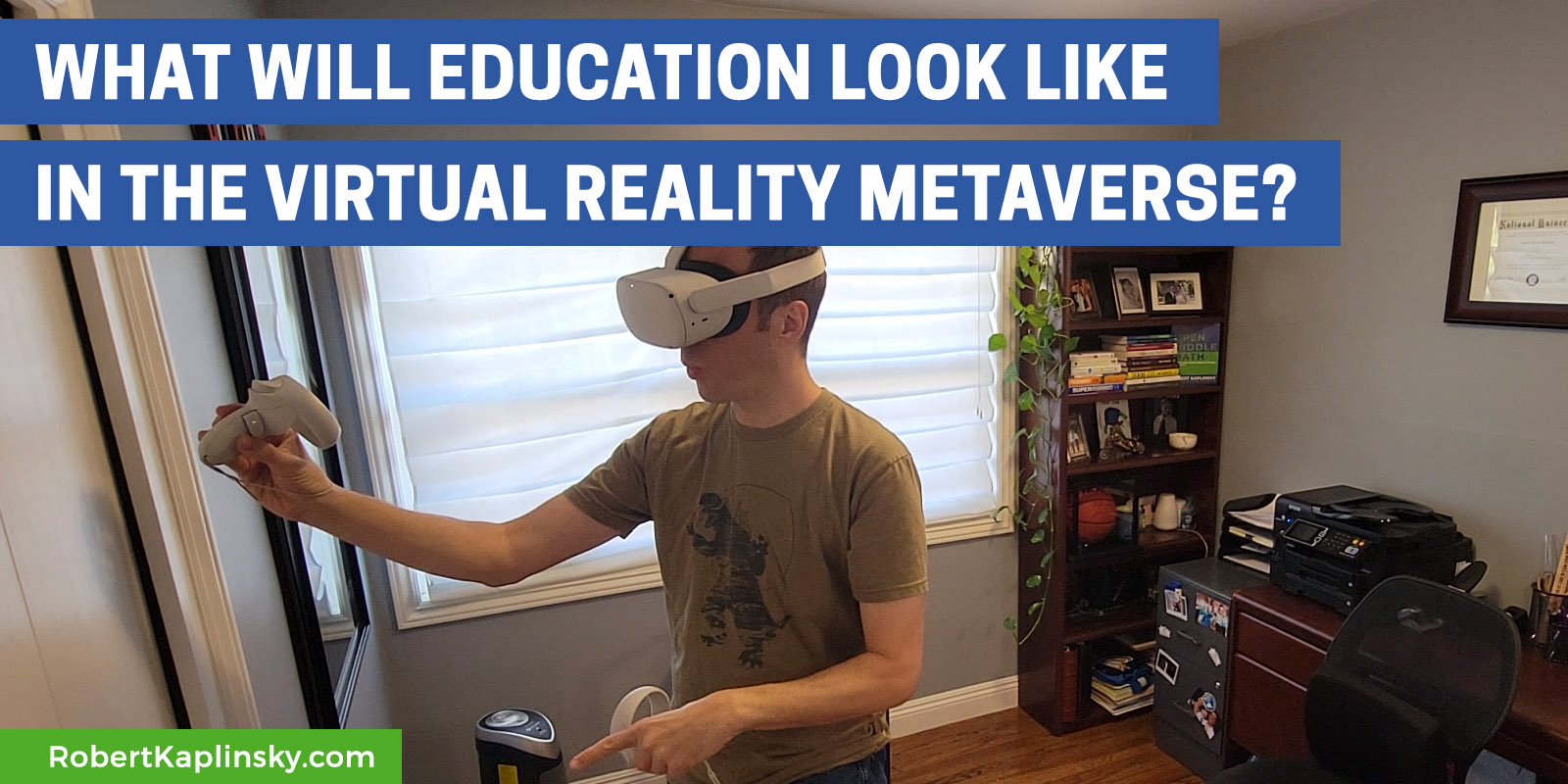I’ve recently started exploring what education and professional development could look like in the virtual reality Metaverse after my friend Mike Flynn suggested that we try it out. I made a series of eight videos to demonstrate this as a proof of concept. Consider that while this might seem crazy or unnecessary right now, if you watched something like this with a Zoom classroom in 2019, it might have felt similarly.
I am using an Oculus Quest 2 with the Horizons Workrooms software. It’s worth noting that the audio of me talking comes from the headset, so it’s a decent quality microphone.
Each video below shows you what I’m seeing in my VR headset on top and what it looks like in real life below. Note that whenever it is black on the VR headset view, I’m actually seeing my room via the tiny cameras in the headset. I assume that this is not being recorded for privacy reasons.
This second video is me exploring what doing an Open Middle problem might be like.
The video might feel a bit jerky as a spectator, but while wearing them it does not feel that way. My eyes and my head work together and it feels very smooth. That doesn’t come across so much in the video experience.
Is it nauseating?
Most motion based virtual reality games (and every single virtual reality ride like Star Tours) makes me extremely nauseous these days. Fortunately, this doesn’t make me feel that way at all.
What else should we know?
The battery life is still not that great so the headset would need to be recharged every few hours. It definitely can’t make it through the whole day. It also really messes up your hair. It gives you something of an inverted mohawk. I don’t wear glasses with it but you need to insert a provided adapter to comfortably wear it.
What are the dimensions of the whiteboard in Horizon Workrooms?
As best as I can determine, when you take an image that is 6975 x 1856 and expand it, it basically fills the entire whiteboard. The ratio is close to 3.75 to 1 but not exact.
Virtual Manipulatives
It would be amazing if we could import virtual tools to use in this space. Imagine base-10 blocks, shapes, number tiles, or even a calculator. I imagine this will come one day, but it’s not here yet.
Individual Desk Whiteboards
Currently everyone has access to a shared whiteboard. So everyone is working on the same writing space at the same time. That’s great for a meeting and less great for a classroom. It’d be even better if each student could have their own whiteboard and then the facilitator could select the one to display and share.
Viewing Other People’s Whiteboards
Building on the last idea, I wish there was a way to see what other people were doing with their whiteboard. I totally get that it’s most likely related to privacy concerns, but as a teacher I’d love to be able to walk around the virtual space and see what students are doing. That currently is not possible unless everyone is working on the same whiteboard at the same time. Then you’d have to partition it into sections so each person could work in their same area.
Method For Recording Room View
Right now there’s no easy way to record the whole room. As far as I can tell, you can only record what you see as a participant. I think I may be able to add a fake participant and record that, but I haven’t tried it yet.
What do you think? What are you curious about? What questions do you still have? Let me know in the comments below.


This was extremely useful! I have read a lot about VR but I have never really seen it in action. I like how your videos included your perspective in the goggles and also what you looked like in real life. I am not sure how I feel about the virtual whiteboard because I feel like my handwriting would not be the best on it (I think it would just take some time to get used to), but I think it is really neat and useful that you can insert images such as the open middle problem.
Thanks Lindsey. Yeah, I had not seen many videos where it showed both inside and outside of VR simultaneously so I thought I’d try to merge them. Yes, handwriting is definitely not ideal yet, but I assume it will get better over time as the technology advances. Partly there’s a fraction of a second delay between your writing and what’s visible, which makes coordination a bit off. There’s also that lack of physical resistance from writing against something which throws me off a bit. That being said, it’s much easier to get acclimated than I expected.
I’m optimistic for the future.
Thanks, Lindsey. I hadn’t seen many videos showing both inside and outside of VR together, so I tried it. Handwriting isn’t perfect yet due to a slight delay and lack of physical resistance, but I think it will improve with technology. It’s easier to get used to than I expected.
I’m optimistic about the future.